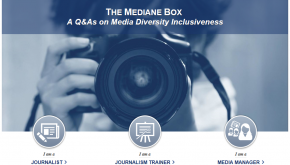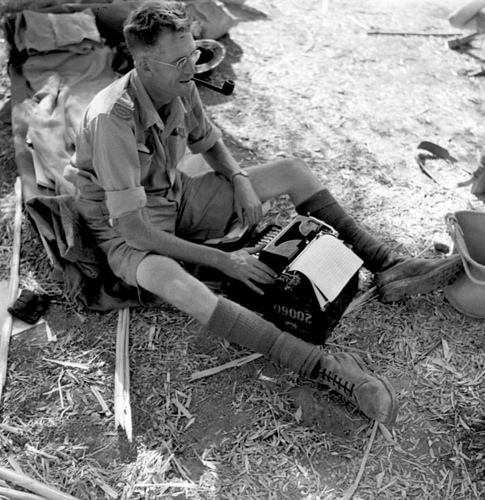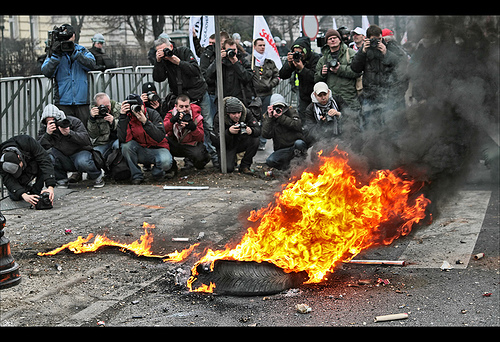 Podczas listopadowej konferencji zorganizowanej w Instytucie Studiów nad Mediami w szwajcarskim Winterthur, zaproszeni paneliści dyskutowali nad związkami pomiędzy dziennikarstwem, nauką o komunikowaniu a interesem publicznym.
Podczas listopadowej konferencji zorganizowanej w Instytucie Studiów nad Mediami w szwajcarskim Winterthur, zaproszeni paneliści dyskutowali nad związkami pomiędzy dziennikarstwem, nauką o komunikowaniu a interesem publicznym.
Barbie Zelizer, dyrektorka Annenberg Scholars Program in Culture and Communication na University of Pennsylvania, poprowadziła dyskusję, gdzie podzieliła się swoimi spostrzeżeniami na temat, jak to zgrabnie ujęła, “schizofrenicznego traktowania dziennikarstwa”.
Co nauka o dziennikarstwie może powiedzieć o zawodzie dziennikarskim?
Jak myślimy o dziennikarstwie w czasach kiedy na dziennikarstwo składa się pisanie zarówno blogów, jak i robienie satyrycznych programów nadawanych późną nocą w telewizji? Jak myślimy o dziennikarstwie, którym zajmują się tak różne dziedziny jak nauka o komunikowaniu, studia o literaturze czy socjologia? Sensowne odpowiedzenie na to pytanie wymaga uświadomienia sobie faktu, że dziennikarstwo jest wszędzie, czyli tak naprawdę nigdzie.
Dziennikarstwo nie tylko przekroczyło granice tego jak wcześniej było definiowane, ale także niekonsekwencja w zajmowaniu się (opisywaniu) dziennikarstwem z badawczego punktu widzenia, jak i samo wykładanie dziennikarstwa wytworzyło sytuację, w której możliwości dziennikarstwa by działało w interesie publicznym są ograniczone. Mimo faktu, że dziennikarstwo jest już tak długo dostępne dla publiczności, która ciągle potrzebuje informacji oświecie, samo dziennikarstwo doświadcza “schizofrenicznej” egzystencji w tymże świecie.
Dzięki uprzejmości profesor Zelizer, czytelnicy stron EJO mogą przeczytać cały artykuł w języku angielskim tutaj.
That statement brought me to a standstill, because the underside of adaptability and its embrace of change – a reading against the grain, if you will – is reactivity and a heightened state of vulnerability to more powerful forces in the environment, a difficulty with asserting one’s voice in a background riddled with competing forces of a technological, economic, political, social and cultural nature. This made me pause, because it suggests that despite extensive curricular and scholarly interventions in and about journalism, we haven’t yet given it what it needs to proactively shape its place in the world.
And so, I’d like to take my time here and focus on four questions, each of which plays a bit with the larger issue of how to help journalism take back its destiny and in so doing addresses the relationship between journalism scholarship, journalism and the public interest. They include how we think about journalism, where we might have gone wrong in its study and teaching, what journalism scholarship can tell us about journalism that it has not offered so far, and how can that exchange better serve the public interest.
How do we think about journalism?
At a time when journalism itself stretches from personalized blogs to satirical relays on late-night television and its study appears in places as diverse as communication, literary studies, and sociology, asking “how do we think about journalism” requires addressing the fact that journalism seems to be everywhere but is in fact nowhere. Not only has its practice exceeded longstanding recognized boundaries of what journalism is, but the inconsistencies in the backdrop of journalism’s study and teaching have helped create circumstances that plague journalism’s capacity to act on behalf of the public interest.
Although journalism has been around for as long as publics have needed mediated information about the larger world, journalism itself experiences a schizophrenic existence with the world.
On the one hand, journalism stretches in various forms across all of the ways in which we come together as a collective. Where would history be without journalism? What would literature look like? How could we understand the workings of the polity? While journalism has been the target of ongoing discourse both in support and critique of its performance, contemporary conditions insist on journalism’s centrality — as a set of practices, a collective of individuals, a profession, and an institution, all with beliefs about what good journalism is. It has high points and low points, and here you’re looking at what many consider one of its higher points in the US context– an acrimonious Q&A relay between Richard Nixon and CBS reporter Dan Rather that got codified as an emblem of aggressive autonomous reporting.
On the other hand, an “it’s just journalism” rejoinder persists whenever journalism is perceived to have done something wrong, and often when it has tried to do something right. Here we’re looking at one of the most longstanding satiric tackles on US journalism, Saturday Night Live’s Weekend Update. But it started long before that. When George Orwell added newspaper quotations to his first book, critics accused him of “turning what might have been a good book into journalism” and similar stories dot the journalistic backgrounds of literary giants like Charles Dickens, John Dos Passos, and Andre Malraux. Derogatory terms for journalistic work – and here I’d list feeding frenzy and gotcha journalism as examples – draw from a negative perception of what journalists do, and journalists remain near the bottom of the list of those professions trusted by the public.
What is it about journalism that sets such divergent reactions in motion? Why is it not more readily appreciated, with all of the contradictions, problems, limitations and anomalies that accompany it? Why have we not been able to do more in facilitating more continuous regard for it? And how has this affected its capacity to serve the public interest?
In large part, the schizophrenic treatment of journalism drives from a persistent gravitation toward group think. What we think relies upon how we think and with whom, and perhaps nowhere has this been as developed as in the sociology of knowledge. Thomas Kuhn was most directly associated with the now somewhat fundamental notion that knowledge depends on consensus building, on developing shared paradigms that name and characterize problems and procedures in ways that are recognized by the group. On the way to establishing consensus, individuals favoring competing insights battle over definitions, terms of reference and boundaries of inclusion and exclusion. Once consensus is established, new phenomena tend to be classified by already proven lines. In other words, what we think has a predetermined shape and life-line, which privileges community, solidarity and power.
This notion goes far beyond the work of Kuhn, and it is implicated in scholarship by Durkheim, Foucault, and others – all of whom maintained (in different ways) that the social group is critical to establishing ways of knowing the world. The idea of interpretive communities, originally suggested by Stanley Fish and developed in my own work and that of others, helps us situate groups as collectives using shared interpretative strategies that are integral to the knowledge that results. Inquiry, then, is not just a cognitive act but a social one too.
What does this suggest about journalism’s place in the world? It offers an invitation to think about the social groups involved in giving it shape. In this sense, no one voice addressing journalism is better or more authoritative than the others. Nor is there any one unitary vision of journalism to be found. Rather, different voices offer more – and more complete – ways to understand what journalism is, each having evolved in conjunction with its own set of premises about what matters and in which ways.
This is critical, for the competing voices addressing journalism’s practice, study and teaching have played a part in maintaining its schizophrenic relationship with the world.
Negotiated across three populations – journalists, journalism educators, and journalism scholars – journalism’s viability has always been under some degree of attack: Everyone says the others don’t get it: Journalists say journalism scholars and educators have no business airing their dirty laundry, journalism scholars say journalists and journalism educators aren’t theoretical enough, journalism educators say journalists have their heads in the sand and journalism scholars have their heads in the clouds.
The heart of everyone’s concern – what to do about journalism and how to better orient it toward the public interest – gets shunted to the side as everyone fixates on who will be best heard above the competing voices. Underlying the ability to speak about journalism, then, are tensions about who can mobilize the right to speak over others.
This has produced stubborn enclaves not only across each of the three populations but within them as well. Longstanding members of the profession have maintained durable bonds that exclude multiple kinds of newcomers – such as satiricists or bloggers. Despite an enormous body of academic literature dealing with the values, practices, and impact of journalism, journalism scholars still have not produced a coherent picture of what journalism is. What this means is that because journalists, journalism educators and journalism scholars function within the boundaries (and confines) of their own multiple interpretive communities, journalism never finds its own voice in serving the public interest.
Journalists themselves have not been receptive to the attempts to microscopically examine what they do, despite the fact that their ground conditions are rapidly changing.
We know that today’s journalists are under siege from numerous quarters. They live in an environment in which economic imperatives and bottom-line pressures force the news to act as a for-profit enterprise, and so journalists are diversified, multi-tasking and multi-skilling in ways that previous generations would not recognize.
Politically, they are under attack from both the left and right, which argue for different definitions of so-called journalistic performance alongside a political environment that keeps undercutting the journalist’s capacity to function in old ways. Journalists thus follow various models of practice, not always thoughtfully and none of which are fully suited to the complexities of today’s political environment.
Technically, journalists face new challenges from the blogosphere and other venues, which make the accomplishment of newswork tenuous. In the US, both mainstream newspapers and broadcast news (other than the morning shows) are losing their publics, while a growth in the ethnic press, the alternative press, in cable news, and in alternative sites like late night television comedy, blogs and other online sites (particularly among the young) suggests that the change in journalism is rapid and widespread.
And finally, morally, scandals like those involving Judith Miller or Jayson Blair in the United States or the Gilligan Affair in Britain have raised questions about the moral fiber of journalists, paving the way for an insistence on homemade media, or citizen journalism, by which journalists’ function is being taken over and performed by private citizens.
Journalism’s landscape is thus changing in multiple ways. The very proliferation of names for journalists who now act alone rather than supported by the backbone of a news organization – and here I refer to multi-media journalists, backpack journalism, Sojos, Mojos, video journalists – suggests an uptick in an evolving form of journalistic practice, which, true to Jeff Jarvis’s words, has journalists obsessing in a reactive frenzy. How can they accommodate change? Who is a journalist – Christiane Amanpour, Jon Stewart or Salaam Pax? Are mobile phones and cameras bona fide instruments of newsmaking? What about tweets on twitter? And what is journalism for – is its function to only provide information or to more creatively meld community and public citizenship?
If we were to follow Jeff Jarvis’ words, highlighting an adaptability to change as the key requirement for journalism moving forward, which of these challenges would lead the way? What would remain journalism’s ground? What would be left in the end, and how much of it would we recognize? Rather, I suggest we need to tweak journalism , changing it from a community that struggles to sidestep blows as they are launched into one that anticipates as much as it responds. Proactively fielding developments in the larger environment so as to delay, blunt or even alter the landing of such blows is instrumental for securing a form of journalism that will work more effectively in the public interest.
Offsetting journalism’s reactivity requires addressing some of the ways in which our own study and teaching have supported a reactive journalism rather than a proactive one.
Where have we gone wrong?
I would like to mention four tendencies:
1) We study and teach journalism through unnecessarily narrowed lenses, which a priori splinter the world in which we presume journalists engage. Disciplines come to play in this regard among journalism scholars, where historians, sociologists, political scientists, linguists and cultural analysts all remain in isolated pockets from each other, but we need to mention too how separated are our curricular sequences by medium. In the United States, for instance, journalism educators still apply demarcations between print and television in our journalism education trajectory, and the AEJMC – the largest journalism association for educators and scholars – boasts similar divisions. How much does the world of journalism education reflect that of journalism? When we factor in the online environment and further yet the multi-skilling that forces journalists to learn to produce multiple platforms for one news story, we begin to realize that journalism has in fact begun to reflect real world experience more than ever before. It reflects an engagement with the world – like ours — shaped not by discipline or medium but as a blended give and take of all of the stimuli that feed into it. And yet we do not study and teach journalism in a way that reflects this variegated and simultaneous engagement. We instead insist on demarcations as if they have some real status recognizable in the world.
2) We study and teach journalism by recycling familiar – but often tired – interpretive strategies for understanding how newswork takes shape in different times and places. I want to mention three examples in this regard. One is that the bulk of our scholarship rests on an all too familiar conversation about journalism involvement, which repeatedly makes the call that journalists are either too involved or not involved enough.
Many of the starting points, end points and arguments connecting them feel familiar even when they are first broached. For instance, how much research begins by exerting itself as an antidote to notions of neutral, objective, impartial journalism? Why have we not yet put that notion to bed? By the same token, how many kinds of journalism identify themselves somewhat breathlessly with so called new modes of participation — advocacy j, public j, citizen j are but a few — all of which take parameters we identified back with the earliest forms of involvement as an impulse touted as newly relevant to news work. In both cases, we see a gravitation towards old frames for identifying what may seem like new problems, offering yet additional configurations that argue for a difference in kind for what remains essentially a difference in degree. If, however, we want to better situate the public interest in the list of journalism’s priorities, then we may need new frames for linking them more effectively.
A second overused interpretive strategy relates to how much our understanding of news has been influenced by organizational logic, where work becomes routinized and controllable, not only for journalists but for academics too. In this regard, we continue to invoke well-worn residual categories – Gaye Tuchman’s what a story, Herb Gans notion of the gee whiz story, are but a few – which suggest that we haven’t yet figured out what to do when the situations on the ground defy or overly complicate our scholarly assumptions. This has real implications for journalism’s capacity to service the public interest, because it fosters expectations of a journalism that works primarily as a predictable and manageable phenomenon and it plays specifically on an understated regard for crisis, seeing it as an exception of journalistic work rather than the rule. With journalists increasingly being charged with addressing crisis as the stuff of news, however, we may need to do a better job of recognizing crisis reporting as a mainstay of journalism, particularly because nowhere is the public interest as high on the agenda as in the wars, terrorism and natural disasters that drive periods of crisis. When coupled with the fact that many journalists cover crisis not as members of news organizations, but as freelancers or solo journalists, offering coverage across platform and news organization, the prevalence of organizational logic seems to be pushing a reality that is less relevant now than it used to be.
And thirdly, the gaps and misnomers in our scholarship still bewilder. We continue to reference newsrooms as if they are central in shaping a journalist’s everyday work life. We have not yet learned to define news – we keep repetitively listing its qualities instead. We continue to treat multi-platform stories and multi-media journalism as if they are curiosities rather than evolutionary necessities.
Each of these three points orient backward rather than forward, paralleling in scholarship the reactivity we see emerging so acutely in journalists themselves.
3) We overly embrace a notion of journalism as autonomous and revolutionary rather than as a phenomenon that needs to work incrementally in tandem with other forces in its environment. We might want to ask why we have such an interest in labeling things from anew? In demarcating new beginnings? In assuming that journalism is dynamic and constantly evolving? Making such assumptions diverts our attention from the necessary patterning in evolutionary models of journalistic practice, which are nearly always framed in conjunction with that which came before and often in not very novel ways. History relentlessly repeats itself: How many “new journalisms” do we have? I count at least five, dating back to the days of Mathew Arnold in 1860, yellow journalism of late 1880s, jazz journalism of 1920s, the literary journalism of the 1960s and stretching all the way to the present reinstatement of so-called narrative journalism. So new by whose standards? And for whose aims? In overstating journalism’s maverick nature we may have instated unrealistic expectations for how it can enact change on its own. This is critical for thinking about how journalism can better service the public interest because it draws from the same lack of regard for the environment as does Jarvis’ flip assumption – that journalists should flexibly adapt to whatever comes their way. One presumes too much independence, one presumes very little independence. Does journalism not lie somewhere in between? In fact, a more modulated understanding of journalism and its environment, one that privileges symbiosis more than independence, plodding incremental change more than revolution, is supported by the fact that certain periods emerge as particularly fertile settings for thinking anew about what journalism could be. Just in the United States, for instance, the late 1800s gave us the penny press, which shortly thereafter devolved into its low and high points — jazz journalism and muckraking, the 1960s gave us renewed forms of neutral, advocate and literary journalism, and most recently, the 1990s/2000s gave us public journalism and citizen journalism as well as a revival of literary or narrative journalism. These periods of temporal pregnancy echo elsewhere in the world too – we can think of the near simultaneous emergence of development journalism and asian values journalism in the 1960s as answers to the deficiencies of models suggested by the global north. Similarly, change in journalism almost always is accompanied by change outside of journalism, as in the rise of the scientific method, the move toward realism in novels and the development of the telegraph which accompanied journalism’s embrace of objectivity. And yet we hear time and again of an end to the old modes of newsmaking because the new has arrived – claims which fail to realize that journalism’s presumably inherent autonomous and revolutionary nature is driven by larger forces in its environment. Those forces push broadly during certain periods toward change in multiple domains, not just journalism.
4) We sidestep complications in our targets of inquiry to focus on what we can most easily account for. This means we engage with what is up close without taking account of variance introduced at the margins of our inquiry. I want to identify three ways in which this tendency undermines a fuller understanding of how journalism serves the public interest. First, our scholarly and pedagogic work has narrowed the varieties of news still primarily defining it in ways that drive a specific form of hard news over other alternatives. This metonymic bias has pushed a growing gap between what Peter Dahlgren long ago called “the realities of journalism and its official presentation of self”, and in much of our research we don’t account for the variety introduced by copy-editors, graphic designers, journals of opinion, satirical late night shows and have instead helped eradicate much of the diversity of news. Second, we have largely sidestepped the craft of journalism.
The academy’s move to professionalize journalists – largely driven by its sociological inquiry — has told journalists they’re professionals (whether or not they want to be) and has raised the stakes involved in being a journalist, often to the detriment of those practicing the craft. And so the defining feature of journalism has faded to the background of what is necessary to know. Finally, we have underplayed the diverse global forms of journalism.
Though news practice takes on unique shape in the various regions in which it is practiced, the vast majority of scholarship still focuses on journalism in its U.S. venues, standing in as a very limited but honorific standard for a wide range of journalistic practices around the world. This leaves unanswered the many questions marks about journalism that dot the global horizon and leaves us hard pressed to argue, in this age of the nation-state’s demise, for any kind of alternative impulse that should be behind the journalistic apparatus if the nation-state has decreased in relevance. This is particularly critical when thinking about the public interest, which does not look the same dependent on one’s geographic vantage point.
With this in mind, what can journalism scholarship tell us about journalism that it hasn’t yet sufficiently offered into the fray?
I think the message is a simple one: Both the academy and journalism refer to clusters of activities that are devoted to the production and dissemination of knowledge. So as a system of knowledge, journalism scholarship is uniquely poised to remind journalism to do two basic things
1) To think broadly, slowly and deeply – accommodating skepticism, doubt and uncertainty as strengths, not obstructions in the journalist’s rush to judgment. Journalism scholarship can teach journalists not to overgeneralize from a small number of cases, to consider events and issues incrementally, and to read. Are there easy answers to financial meltdown, global warming, disease? Or has journalism offered us the illusion of easy answers that don’t fit the complexity of the circumstances being covered. A related, though no less important question: when did those in journalism decide that the public can’t understand complexity?
2) To remember that journalism is bigger than the here and now moments that drive it as part of its 24/7 news cycle. Enlarging upon the “here” moments means paying attention to the spatial parameters in which both journalists and journalism scholars reside. Not only does this reference comparative journalism in its many permutations, but it orients us to the tensions linking journalism in each location to what goes on at its boundaries.
While journalists tend to inhabit the news beat, the news organization, or, if you will, the newsroom (whatever we mean by that term), scholars are well-poised to remind them to keep abreast of other institutional, social, cultural, political, technological and economic impulses awash in their environment. This means pulling in a whole host of contextual variables that complicate the space of news, not only by compressing it into reactivity: Post-authoritarian regimes, for instance, where transitional circumstances imply a forward-looking movement that does not take shape as expected, and here I’m thinking of circumstances in post-Soviet Russie or in multiple East African states, or the involvement of social media to draw in news users not ordinarily attentive to the news, and here this stretches from the whimsical, as in celebrity sighting, to the serious, seen in the recent Iranian demonstrations. Each development can and should be explained by looking beyond the here moments targeted by journalism, and it is our responsibility to help journalists recognize them as relevant.
Enlarging upon the “now” moments means that we can better help journalists attend to history – to the multiple temporal frames which we as scholars regularly and systematically engage in treating journalism as a target of our inquiry. This not only includes understanding why we harken back to the old in describing the new – as in the repetitive invocations of new journalism, for instance – but offers a persistent reminder that all environments have had multiple repetitive experiences over time. Journalism itself is awash in them: Is the online explosion so very different from the expansion into radio in the 1920s? Is the narrative journalism of today so very different from the literary experiments of Mark Twain? Were there non-journalistic circumstances at both points in time that made journalism’s turn to new technology, in the first instance, and to literary storytelling, in the second, into an obvious development?
What does this mean for journalism? It means not adapting to change, as Jeff Jarvis would have it, but riding the wave of change as part of its mantra for being. Not as a responsive reactive mode but as a proactive and anticipatory understanding of the multiple spatial and temporal forces that exist in various symbiotic relationships with the news.
In real terms this calls for an increased orientation on the part of journalists toward other forces in the public sphere, for an increased degree of transparency about how journalists work, and for an increased recognition that others may be able to critique journalism better than journalists for the very reason that they look at journalism from its margins. Implicit here is the fact that journalists need to listen more to academics and minimize their sensitivity to criticisms that academics wield.
At the same time, scholars need to be more available to journalists – to write in terms they can understand, to craft arguments that are consonant with journalists’ experience. The real world of journalism needs to be more firmly grounded in our work. In the United States, much talk has recently targeted the idea that the academy can pick up and correct the ills wrought by corporate ownership of newspapers. Just two weeks ago, a new report by Michael Schudson and Leonard Downie argued for alternative modes of funding journalism – philanthropy, universities, non profits, government. Regardless of whether that plays out, we need additional forums for bringing journalists and journalism scholars together – journals publishing them side by side, forums in which they interact on common issues, platforms in which they carry on investigative and scholarly work together. I note here the now defunct Freedom Forum Center for Media Studies at Columbia University, which provided just such an opportunity to better understand the other side. The fact that few other forums exist that quite reproduce that experience suggests that neither side has made exchange a targeted goal. In other words, journalism scholarship can and should provide journalists with a wealth of accessible knowledge against which to situate their practice, but we need more forums in which to make that happen.
Finally, what does any of this suggest for the public interest? My message should by now be clear: Everything I have noted thus far is applicable to journalism’s servicing of the public interest. A more proactive journalism, a journalism with more self-understanding of itself across time and space, a journalism that is more transparent and more amenable to reflection from the outside – all of these are pre-conditions for journalism to work more effectively in the public interest. Likewise, a journalism scholarship that facilitates these qualities ultimately works to public benefit too.
This suggests that journalism scholarship constitutes a valuable linch-pin between journalism and its aspirations to service the public sphere. It offers the tools through which to stead journalism against political attacks which lack historical understanding, to help it better contextualize commercial onslaughts, to offset the hysteria of moral panics which see new technological developments as changing old relationships between young and old or private and public.
In servicing the public interest by better connecting journalism scholarship and journalism, we hearken back to something John Dewey said long ago about education: arriving at one goal is the starting point of another… we only think when we are confronted with problems.
It is our role as intellectuals to keep those problems coming. But we can only do so if we reinvigorate our scholarly lenses enough to offer journalists new ways of regarding their role in servicing the public interest. An energized exchange between journalism scholarship and journalism serves the public interest because it will in the end orient the public toward a broader understanding of how journalism works. Journalists are not responsible for the world, but journalism scholars are instrumental to enabling a better connection between journalists and their world. Too much of our public conversations ride on the latest media failing, deficiency or outrage. We have a critical role to play in making available to both journalists and the public the tools to create less of a blood-letting atmosphere than the one in which we now reside.
Journalism is too important to be reactive. We need to help foster understanding of its trappings in ways that help both journalism and the public interest thrive – each on their own terms and together.
Article contributed by Barbie Zelizer, Director of the Annenberg Scholars Program in Culture and Communication
TagiAnnenberg School for Communication, badania nad dziennikarstwem, Barbie Zelizer, Instytut Studiów nad Mediami, interes publiczny, studia nad mediami

















